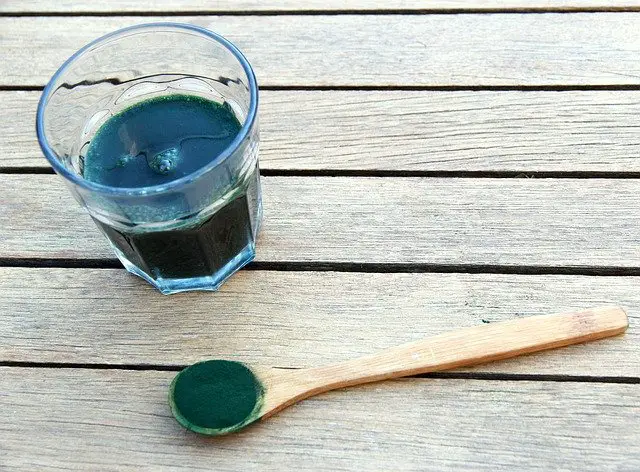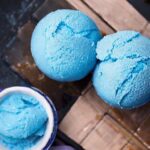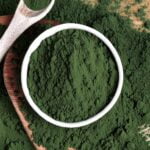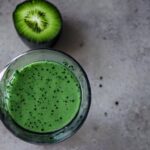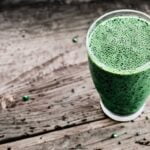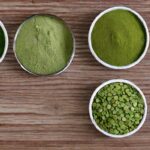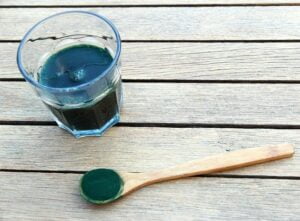
You may have heard about Blue Spirulina as a new superfood or seen an Instagram post of a vivid blue drink with a caption about “Blue Majik”.
In this post, we will look at what blue spirulina is, where it comes from, and the benefits of spirulina. But also the one major danger in it that has led me to stop taking spirulina altogether.
What is Blue Spirulina?
Spirulina is a certain type of blue-green algae. Blue-green algae are several species of bacteria that grow in freshwater lakes, ponds, streams, and saltwater. Although often referred to as algae, blue green algae are not algae at all, they are types of bacteria called cyanobacteria.
Countries in Africa and Mexico have used them for hundreds of years as food, so they have shown a history of being safe. The Aztecs are believed to have used it in the 16th century, harvesting it from Lake Texcoco. And it may date back over a thousand years to Chad in the 9th century when communities have harvested it from the shores of Lake Chad.
Although these algae are found in nature, some are grown in controlled environments, which actually reduces some of the contaminants that might be found in them otherwise.
So that’s where Green Spirulina (Arthrospira platensis) comes from.
What is Blue Spirulina Made Of?
Blue Spirulina is made directly from Green Spirulina. A blue-colored phytochemical called phycocyanin is extracted from the green spirulina, and the result is a powder sold as Blue Spirulina. (One of the names for this is Blue Majik powder)
Remember that Spirulina is a type of blue-green algae. Regular Spirulina looks mostly green, but it has a hint of blue to it as well. That slight blue color is caused by phycocyanin. So the Blue Spirulina is just the blue part of the spirulina (the phycocyanin) extracted out and sold by itself as Blue Spirulina powder.
A lot of times bright colors can be an indicator of antioxidants, and with Blue Spirulina that’s what we get. A high dose of the antioxidant that’s found in regular spirulina.
Blue Spirulina & Blue Majik Guide Video
Blue Spirulina vs Green Spirulina
What’s the difference between spirulina and blue spirulina? Well, blue spirulina comes directly from green spirulina as an extract. So green spirulina is more in the whole form and natural state.
Because Green Spirulina is in a more whole form, it contains more nutrients such as vitamins and proteins and other antioxidants and phytonutrients, as well as the antioxidant phycocyanin. Think of it like eating an orange in its whole form, versus extracting the vitamin C to take by itself.
One argument for green spirulina being better is that foods are known to work better synergistically and as a whole, rather than taking each part individually. So, taking the blue spirulina is a little like taking the extracted vitamin C. It’s still a good thing, but probably not as good as eating the whole orange which already has the vitamin C, and getting all the additional nutrients and synergistic effects from it. (See WFPBD Ultimate Guide for why it’s better to eat plants and food in their whole form.)

But blue spirulina might be an even better thing than green spirulina for this reason. One of the main benefits of regular green spirulina is its super high antioxidant levels. It is thought to fight inflammation (anti-inflammatory) as well as free radicals, due to its high levels of antioxidants.
Studies and research have shown that Spirulina may have anti-cancer benefits. Due to its high antioxidant levels and prevention of inflammation, it’s thought to fight cancer as well as other diseases. Research on animals has shown it can shrink tumors and reduce cancer occurrences. Also, there have been positive effects against mouth and oral cancer when studied on patients in India, compared to a control group. Those studies are found here and here.
Basically, the main antioxidant at work in Green Spirulina, which is fighting all these diseases, is phycocyanin (blue spirulina). (In fact, Spirulina alone has 280% more antioxidants than blueberries, already a high antioxidant food.) So when the blue spirulina is extracted, now it is a much higher concentration of the antioxidant, the main disease-fighting agent.
So in this sense, you might be getting much more of the health impact of green spirulina when you take blue spirulina. The antioxidant concentration would be much higher in blue spirulina. There are no studies I have found to compare green vs. blue spirulina. If I do find any, I will update this in the future. If anyone should know of any, please leave a comment or contact me.
One of the further benefits of blue spirulina over green is the taste. For many, they don’t like the taste of green spirulina and it reminds them of a fish tank, even the smell. Remember, it comes from freshwater sources such as ponds! You can read more about the Spirulina taste at What Does Spirulina Taste Like?
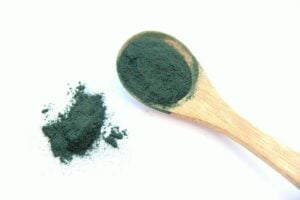
One final thing to consider though is cost. Blue spirulina is much more expensive ounce for ounce compared to regular spirulina. At the time of this writing, on Amazon, blue spirulina is 10 times the cost of green spirulina.
So even though you can get a higher concentration of antioxidants in the blue powder form, I don’t see it being worth it since you could get the same amount of antioxidants (just by consuming more of it), plus all the extra benefits of regular spirulina, for the same price or less.
The only reason I see going for the blue spirulina over green is if you really don’t like the taste, you are looking for natural blue food coloring, or you don’t really care about the price.
Blue Spirulina Taste
Because Green Spirulina is the whole form of blue-green algae, the green spirulina taste is a lot like algae and has a strong fishy taste and flavor. But since Blue Spirulina is extracted, Blue Spirulina has a very neutral taste.
This might be much preferable to someone who doesn’t like the stronger taste of regular spirulina. With Blue Spirulina you can get some of the spirulina benefits while having a very neutral and flavorless taste. So basically, Blue Spirulina has very little taste or just tastes like nothing at all.
Is Blue Spirulina Vegan?
Blue Spirulina is vegan since it is completely plant-based and contains no animal products at all. There is a concern for vegans taking spirulina or blue spirulina, since the pseudovitamin B12 found in spirulina may compete for absorption in the body with regular B12. We will address this further down under Dangers of Spirulina.
For this case, it may not be recommended for vegans to take, who already might struggle to get enough B12 due to the fact that almost all B12 comes from animal products.
Is Blue Spirulina Natural?
It’s hard to say if blue spirulina is truly natural or not. Regular green spirulina is natural and it is found naturally in nature. But, blue spirulina is not.
Blue spirulina is extracted by scientific means from green spirulina, which is a natural product. So blue spirulina does come from a natural source, but it is not naturally found on its own without scientific intervention.
Blue Spirulina Health Benefits
Spirulina is very high in protein and antioxidants as well as having some B vitamins and Vitamin A, C, D, E, and K. The Intergovernmental Institution for the Use of Micro-Algae Spirulina Against Malnutrition (IIMSAM) recommends Spirulina in the fight against global malnutrition and the World Health Organization (WHO) has supported it, calling it “best food for the future” to combat malnutrition, especially in kids.
It’s high in iron and plant-based protein with 18 of 22 amino acids including all nine essential amino acids and can be safely administered to kids. It’s even been called one of the most nutritionally dense foods in the world. But I think that is not entirely true if you look at the nutritional breakdown. Pound for pound this might be true, but you would have to consume lots of it to get the same amount of these nutrients as you can get elsewhere. The real benefits lie in the antioxidants and other qualities, that we will look at later.

Nasa has approved Spirulina as a space food due to its nutrient density and ability to be grown in space. I’ve seen that one gram of it has the same nutrient density as 1000 grams of various fruits and vegetables, but I haven’t been able to verify that yet.
Blue spirulina is also high in vitamin B12, but as we will look at later, this is actually a pseudo B12 which might have negative effects.
What is Blue Spirulina good for?
Blue Spirulina is good for many things and carries many benefits. Since green spirulina and blue spirulina are closely related, we’ll look at the benefits that could be applied to blue spirulina. Since it’s mostly green spirulina that has been studied, we’ll apply the antioxidant benefits to blue spirulina, since it is the antioxidant.
Antioxidants
These antioxidants are the reason for its success against tumors and cancers as mentioned earlier and other inflammatory conditions.

Your body goes through a process of oxidation, which produces compounds that can damage your cells and tissues including protein structures, cell membranes, and even DNA. Inflammation and oxidation can increase the risk of developing chronic diseases including cancer.
Antioxidants help to fight against this process and some of them can come from our food sources. Inflammation creates more oxidation, and more oxidation then creates more inflammation. So it’s a cycle that needs to be stopped if possible. That’s where our nutrition and healthy food sources come into work and can help.
Spirulina’s most powerful antioxidant is phycocyanin as mentioned earlier. This is what blue spirulina is. The pure phycocyanin antioxidant. (So the health benefits for spirulina will be very much the same as phycocyanin health benefits. And since it’s also blue-green algae, blue-green algae benefits will be the same as well).
Phytonutrients
Both blue and green spirulina also have lots of phytonutrients as well. You can find out more about phytonutrients here. These phytonutrients that spirulina contains are phenols, flavonoids, and polysaccharides. Just know that these phytonutrients contribute to spirulina’s anti-inflammatory and antioxidant qualities. The polysaccharides found in spirulina give it its immune-enhancing properties.
Spirulina can also increase the activity and number of microphages. These are white blood cells that can eat up pathogens and early cancer cells. Link Another benefit of blue-green algae (Spirulina) is that it increases the activity of natural hunter cells which attack viruses and tumors. It also protects cells of the immune system from damage and toxins. Study Study Study

Lower Cholesterol
Spirulina can lower total cholesterol, “bad” LDL cholesterol and triglycerides, and raise “good” HDL cholesterol. In this study and this study patients had positive impacts on cholesterol after taking Spirulina. This can lead to a lower risk of heart disease. Furthermore, “bad” LDL cholesterol can become oxidized in the body, further leading to heart disease. Spirulina was found in studies to significantly reduce this oxidative damage, due to its antioxidants.
Anti-Cancer
As noted earlier, Spirulina has been found to have anti-cancer properties and also to fight against tumors.
Lower Blood Pressure
If you are someone who struggles with high blood pressure, Spirulina was found to lower blood pressure in individuals who were taking 4.5 grams per day. Study Study This is thought to be because of an increased production of nitric oxide in the blood, helping blood vessels to relax. Also, the diastolic pressure is considered to be the more important reading for blood pressure, and it was found drastically reduced in those taking Spirulina.
Brain Health
As far as brain health, Spirulina has been shown to protect brain cells against damage. It has been shown to have protective effects against dementia. This is because dementia is a result of oxidative damage. Antioxidant-rich foods such as Spirulina help to combat this damage.
Liver Health
Spirulina was found to also help liver health by lowering inflammation. A study on humans helped show it reduced symptoms of fatty liver disease.
Reduce Allergies
If you are someone who suffers from allergies or asthma, Spirulina was found to help allergy suffers by lessening allergy symptoms. Spirulina suppresses the creation of Th2 cells, which contribute to inflammation. One researcher of a study wrote, “Spirulina is clinically effective on allergic rhinitis when compared with placebo.”
Improve Anemia
For those who might have anemia, Spirulina might prove to be a help as well. In this study of older individuals with anemia, Spirulina supplementation was able to increase the hemoglobin content of red blood cells and improve the immune system.
Improves Athletic Performace

If you are an athlete, Spirulina might give you a boost by increasing endurance and greatly increasing the time it takes to fatigue. Men who were used to jogging were able to sprint longer periods of time before fatiguing. It might be beneficial since exercise increases oxidative damage, leading to muscle fatigue, and Spirulina can help against this with its high antioxidant level.
Lowering Blood Sugar
Also, Spirulina has proven effective in lowering blood sugar levels in animals. One study on humans proved effective as well for lowering blood sugar levels a good amount. A meta-analysis found that it was good at lowering fasting blood sugar and studies show it may improve insulin sensitivity.
Remove Heavy Metals
One final benefit is the idea that phycocyanin (Blue Spirulina) can bind with heavy metals in the body and help remove them. One study showed that Spirulina might be beneficial for those with high arsenic levels.
Are you impressed with all of these benefits? No wonder it’s called a superfood. Spirulina has been shown to reduce the risk of cancers, lower the risk of heart disease, lower blood sugar levels, improve insulin sensitivity, fight anemia, improve blood lipid levels, improve athletic performance, protect the liver, and more. With all of these benefits, it makes me want to find my old bottle of Spirulina and start taking it again.
Here’s a quick list of all the benefits of spirulina we just covered.
- Fights free radicals in the body
- Improves the immune system
- Lower cholesterol
- Reduce blood pressure
- Anti-cancer and anti-tumor properties
- Improve and protect the brain
- Improve liver health
- Help with anemia
- Improve athletic performance, especially for endurance athletes
- Reduce blood sugar levels
- Remove heavy metals from the body
- Joint health
- Improve inflammation
Danger of Spirulina
Spirulina has been found to be largely safe for most people. Link Although regular Spirulina has been found fairly safe and regarded as a health food, blue spirulina has not been tested long term. But there is a concern about spirulina we will look at.
There may be a danger of spirulina with regards to Vitamin B12 in the body. Although spirulina is touted as a vegan source of B12, and while it’s true that the B12 level is very high, it is not the same B12 that is found elsewhere or in animal products.
Spirulina instead has a pseudovitamin B12, which is a form of B12 analogue that is said to compete with actual B12 for absorption in the body. This means it could potentially have the opposite effect and instead of supplying B12, might actually cause a greater B12 deficiency! This would also affect the absorption of any B12 supplements.
Because of this spirulina may not be a great product, especially for vegans or vegetarians who already lack a lot of B12 in the diet. Or for anyone in that matter, since it has been found that most people are actually deficient in B12, including meat-eaters.
Final Thoughts
So there you have it. Blue spirulina seems to carry tons of benefits, and so does regular spirulina. But, due to the fact that it might block B12 absorption, I can’t recommend it as a product. A lot of the benefits that people seek in blue spirulina can be gained from just eating a whole food plant-based diet with lots of other healthy foods.
Is spirulina only something that benefits much more for those not on a healthy diet, since they are not getting a lot of antioxidants from other foods? Or does someone who is eating a very healthy diet still gain from the special benefits that spirulina has above other healthy foods? These are questions I still have.
But with the possible danger of spirulina blocking B12 absorption, I have stopped taking it.
Lance has been passionate about the plant-based diet and we have been following a whole food plant-based diet for over 5 years. We focus on health, natural healing, weight management, animal rights, and the health of the planet and environment by focusing on whole plant-based foods and sustainable practices.
Learn more at the About Me page and follow on social media at the links below.

